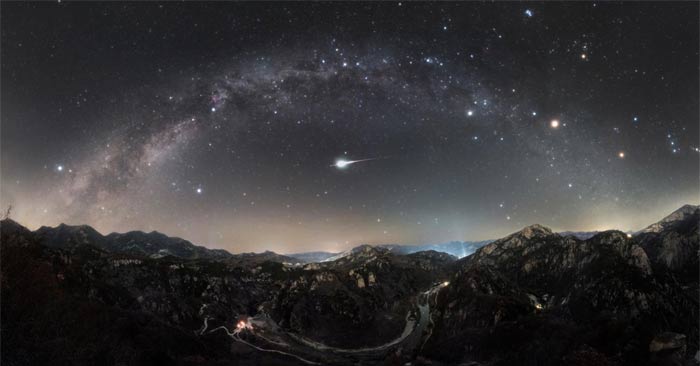Orionid Meteor Shower 2025: Everything You Need to Know
The Orionid meteor shower is one of the most famous and anticipated meteor showers on the annual calendar. You can see it from all over the world. Here's what you need to know about the Orionid meteor shower .

In 2025, the Orionid meteor shower will run from October 2 to November 7, peaking on the night of October 22 between midnight and dawn. However, you may be able to see the shower for several days on the day of its peak.
What is the Orionid meteor shower?
Some consider the Orionid meteor shower to be extra special because the meteors are actually pieces of comet 1P/Halley, also known as Halley's Comet. This comet only passes by Earth once every 75-76 years, but this annual shower can make up for missing out on this once-in-a-lifetime event.
As the comet travels around the Sun, it leaves behind a trail of small pieces of debris. The comet debris enters our planet's atmosphere at about 41 miles per second, where it vaporizes due to friction with the air, creating the streaks of light we call shooting stars.
When is the Orionid meteor shower?
The Orionid meteor shower occurs in late October each year, peaking around the 21st. Although the Orionid peak is supposed to be on October 22, 2025, there is actually a broad peak that lasts about a week.

| Meteor shower name | Peak day | Normal limits | Speed/hour | Describe |
| Orionids | 10/22 | 2/10 - 7/11 | 15 | High speed, related to Halley's comet. |
How to observe the Orionid meteor shower
Meteor hunting, like the rest of astronomy, is a waiting game, so it's best to bring a comfortable chair to sit in and wrap up warm, as you may be out for a while. The Orionid meteor shower can be viewed with the naked eye, so no binoculars or telescopes are required, although you will need to let your eyes adjust to the dark.
In 2025, the new moon will be on October 21, coinciding with the week-long shower's peak around October 22, meaning skies will be clear and dark enough for you to spot the best Orionids.

Best Places to Watch the Orionid Meteor Shower
You should find a safe location away from street lights and other sources of light pollution. You can see the Orionid meteor shower from anywhere in the sky, so it's best to be in an open space where you can scan the night sky with your eyes. But if you follow the meteors' paths, they appear to originate from the constellation Orion.
You should read it
- Tonight there will be meteor shower Leonids, and in Vietnam it can be observed
- Early in the morning, Venus and Jupiter will meet in the sky, don't miss this magical, rare moment!
- The most anticipated astronomical events of 2017
- The most beautiful meteor shower of the year and amazing astronomical phenomena in August
- A 30-ton meteorite was discovered hitting Earth 4,000 years ago
- Amazing blue meteor attacks the red heart nebula
- The meteor glows and dissolves leaving a golden light trail winding in the sky of Japan
- Did you know: 50 tons of meteorite fragments are attacking the Earth every day
May be interested
- The Truth About Yoga That Trains Your Mind and Body
 yoga has spread all over the world and people can practice it everywhere. however, here are some interesting facts about yoga that many people may not know.
yoga has spread all over the world and people can practice it everywhere. however, here are some interesting facts about yoga that many people may not know. - How to enable/disable battery saving mode on Windows 11 laptop
 windows 11's battery saver mode is a feature designed to extend the battery life of your laptop.
windows 11's battery saver mode is a feature designed to extend the battery life of your laptop. - How do you know if a computer problem is hardware or software?
 it's not always easy to determine why your computer isn't working, and figuring out the cause of the problem can often be frustrating.
it's not always easy to determine why your computer isn't working, and figuring out the cause of the problem can often be frustrating. - iPhone does not automatically fill in OTP code – Help iFan handle it
 annoyed because your iphone doesn't automatically fill in the otp code? quickly apply the solutions shared by tipsmake in the article to fix it!
annoyed because your iphone doesn't automatically fill in the otp code? quickly apply the solutions shared by tipsmake in the article to fix it! - Programming the game Cat and Mouse with Scratch
 we have learned how to program the game catching apples and racing animals with scratch. next, let's learn how to program the game cat chasing mouse.
we have learned how to program the game catching apples and racing animals with scratch. next, let's learn how to program the game cat chasing mouse. - 8 Built-in Android Features to Help You Stay Productive
 android devices are packed with features that can help you maximize your productivity. whether you're a professional or a student, these productivity-focused features can help.
android devices are packed with features that can help you maximize your productivity. whether you're a professional or a student, these productivity-focused features can help.






 Vietnam can observe the Orionid meteor shower tonight and tomorrow morning
Vietnam can observe the Orionid meteor shower tonight and tomorrow morning Do not miss the opportunity to admire the largest meteor shower of the year tonight, can be observed with the naked eye
Do not miss the opportunity to admire the largest meteor shower of the year tonight, can be observed with the naked eye Tonight there will be meteor shower Leonids, and in Vietnam it can be observed
Tonight there will be meteor shower Leonids, and in Vietnam it can be observed Early in the morning, Venus and Jupiter will meet in the sky, don't miss this magical, rare moment!
Early in the morning, Venus and Jupiter will meet in the sky, don't miss this magical, rare moment! The most beautiful meteor shower of the year and amazing astronomical phenomena in August
The most beautiful meteor shower of the year and amazing astronomical phenomena in August